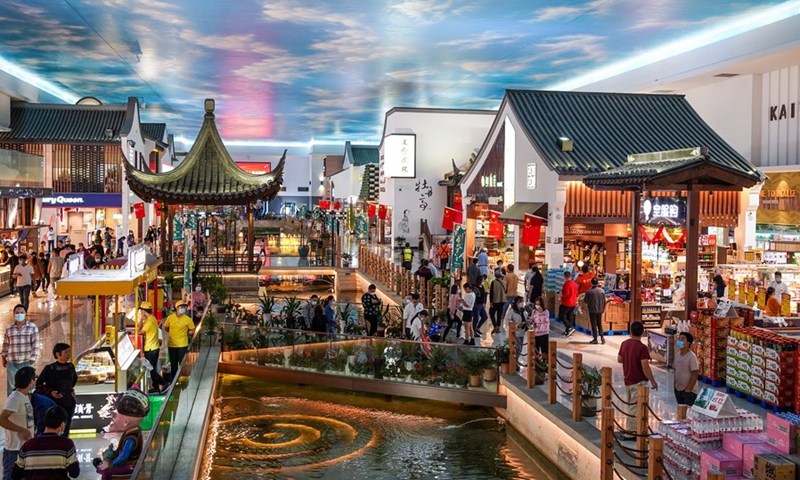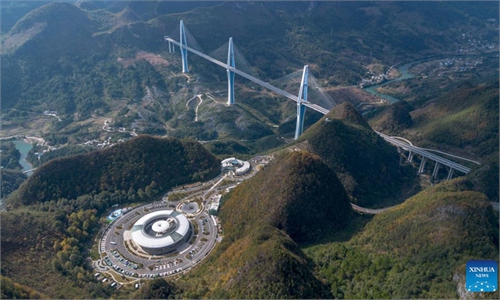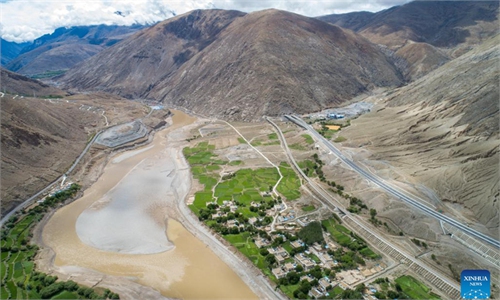
Travellers visit Yangchenghu Expressway Service Area along the Shanghai-Nanjing Expressway in Suzhou, east China's Jiangsu Province, Oct. 8, 2020. Photo: Xinhua
As self-driving tourism gains popularity in China, highway rest and service oases are drawing crowds and creating new consumption opportunities.During the summer travel peak, some rest and service oases have upgraded their facilities and worked with local tourism spots, turning "service oasis plus tourism" into a summer travel highlight and a boost for local economic growth.
The Luhun oasis in Central China's Henan Province recently saw a surge in visitors, with parking spots hard to find on weekends.
"Since the summer began, the Luhun rest and service oasis has seen a daily average of more than 13,000 visitors and 4,000 vehicles, with passenger and car traffic up more than 30 percent and revenue rising 10 percent compared with last year," Ge Changbo, the manager of Henan Transport Investment Expressway Service Area Management Co, Lu Hun Service Area told the Global Times on Thursday.
Visitors can enjoy a leisurely stroll along the waterfront boardwalk, watch the sunset from the viewing platform and savor the newly introduced reservoir fish feast, while children use the playground, Ge said.
"Our service oasis is near popular attractions like Baiyun Mountain and Laojun Mountain, so many visitors choose to stop here for a 'mini vacation' for one or two days," Ge added.
"On our drive from Beijing to Henan, this service oasis was most impressive. The sunset over the reservoir was breathtaking, and the fish tasted good. We only planned a short stop but ended up staying for more than four hours," a tourist surnamed Chen from Beijing told the Global Times on Thursday.
Yangchenghu Rest and Service Area in East China's Jiangsu Province, known as the most beautiful oasis on Chinese social media, draws many visitors with its Jiangnan-style architecture and complete facilities.
"I love this area for its classic Suzhou-style garden designs, which bring back fond memories for those from the region. The outdoor garden is perfect for a peaceful walk to refresh myself and offers great spots for photos," Lu Yu, a resident of Jiangsu, told the Global Times on Thursday.
The area feels like a small shopping mall, with coffee, tea, ice cream and even zongzi (glutinous rice cakes wrapped in leaves), Lu added.
While some service oases are well-known for their natural beauty, some are attractive for their rich cultural content.
After two months of upgrading, the Huanglishu Service Area near Nanjing, Jiangsu Province, features cultural themes from 80 years ago. Walking into the main hall feels like stepping back to the streets of old Nanjing.
More than 50 authentic local dishes, cultural garments and Jiangnan-style specialties have expanded visitors' shopping options, according to a CCTV report.
"China's highway system has expanded, along with the rapid growth of private car ownership, and economic development has fueled the rise of road trips and the popularity of service oases," Jiang Yiyi, a vice president of the School of Leisure Sports and Tourism at Beijing Sport University, told the Global Times on Thursday.
From July 1 to August 12, average daily traffic on national highways reached 34.78 million vehicles, according to the CCTV report.
Highway data reveal that summer travel peaks mostly on weekends, with compact cars accounting for 77 percent of the traffic, a slight increase from 2023, showing that road trips remain a top choice for travelers.
"The combination of transportation and tourism has emerged as an innovative trend in recent years. With the growth of road trips and the transformation of service oases to include tourism features, we can expect more hot spots to appear along national highways," Jiang noted.



